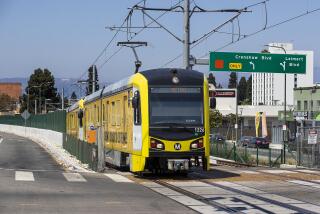Katella Ave. ‘Super-Street’ Plan Advanced : Traffic: Supervisors override residents’ objections in approving environmental impact report.
SANTA ANA — The Orange County Board of Supervisors paved the way Tuesday for the transformation of Katella Avenue into a $55-million “super-street,” despite the bitter opposition of some local residents.
Vocal protesters urged the board to reconsider the plan, flashing signs that read: “No Katella Super-Street” and “Protect Our Property Value.”
Under fire was a plan to widen roads, tighten parking, add bus turnouts and synchronize traffic lights to turn Katella Avenue into a super-street that could carry traffic smoothly at 45 m.p.h. The reconfiguration would offer drivers an alternative to the county’s clogged freeways.
Residents maintained that plans for the massive improvements along a 14.5-mile stretch of Katella Avenue, spanning five cities, would devastate their neighborhoods and leave them at the mercy of a virtual freeway.
Several speakers complained that government officials have kept the public in the dark about the project, even as they made plans to buy out some local properties that sit along the proposed super-street route.
“We’re sitting in no-man’s land,” said a tearful Bonnie Alba-Bernal, who lives in an unincorporated area and fears that her property will be seized by the government under its right of eminent domain.
Unswayed, county supervisors approved a massive environmental impact report for the project, as required by the state before such changes can be made. Several officials sought to assuage the residents’ fears, telling them that approval of the environmental report was only a perfunctory move and that key decisions still remain before the project can move forward.
“I think there’s been a misunderstanding . . . that the County Board of Supervisors is going to set the (route) alignment today and take my house,” Supervisor Don R. Roth said. Instead, he and other officials said, Tuesday’s decision only sets in motion the process for allowing cities affected by the project to consider improvements on a piece-by-piece basis.
Tuesday’s vote allows design work to begin in coming months, and officials hope to start construction within two years. However, some portions of the project might not be undertaken for another 20 years, officials said.
The Orange County Transportation Authority would finance the project through funds raised from Measure M, the half-cent sales tax for traffic improvements approved by voters in November, 1990.
Construction has already begun on a Beach Boulevard super-street. Katella Avenue is one of the highest priorities among nearly two dozen other proposed super-streets targeted as part of a 220-mile network in Orange County.
OCTA Chief Executive Officer Stan Oftelie said before the vote that he considered the supervisors’ approval of the environmental report a key step toward realizing the Katella thoroughfare.
“It finalizes the (route) approach and lets residents know what properties will be taken. It’s clearly very significant,” he said.
Residents clearly agreed at Tuesday’s hourlong hearing, often shouting their frustrations during the course of the meeting. Thirteen business people, homeowners and residents addressed the board--all in opposition to the plan.
Mel Peterson, a representative of the 3,700-member Rossmoor Homeowners’ Assn., said he believes that the super-street project would mean a 10% drop in property values for some local homeowners, while other residents said they were worried about the prospect of having to move altogether. Many residents said they felt helpless trying to stop the mammoth project.
“This thing’s coming regardless of what we say,” Tom Gill of Anaheim told the board.
Katella Avenue Super-Street Transportation officials are making plans to transform Katella Avenue into a more efficient, streamlined thoroughfare. The first such project is underway on a 10-mile segment of Beach Boulevard. A 220-mile network of 21 “super-streets” is planned. Within a few years, improvements are expected on Imperial Highway, Moulton Parkway, Harbor Boulevard and Warner Avenue. A. Turn Lanes Change: Additional left-turn lanes added and right-turn lanes carved into curb. Gripe: Business owners fear their buildings will be torn down. Residents of Rossmoor don’t want a turn pocket proposed at a residential cross street because it might mean more traffic. B. Medians Change: Long concrete medians to improve safety and reduce left turns into driveways. Gripe: Some business owners say they will lose customers without left turns into their parking lots. C. Lanes Change: An extra traffic lane in each direction. Gripe: Property owners fear loss of land, businesses predict loss of drive-by customers. Residents foresee increased noise. D. Parking Change: Restrictions on curbside parking. Gripe: Business owners believe loss of curbside parking will deter people from stopping. E. Bus Stops Change: Turnouts for buses to load, unload passengers without blocking traffic. Gripe: Business owners say turnouts in front of their stores will reduce store visibility and discourage drive-by customers.
More to Read
Sign up for Essential California
The most important California stories and recommendations in your inbox every morning.
You may occasionally receive promotional content from the Los Angeles Times.









